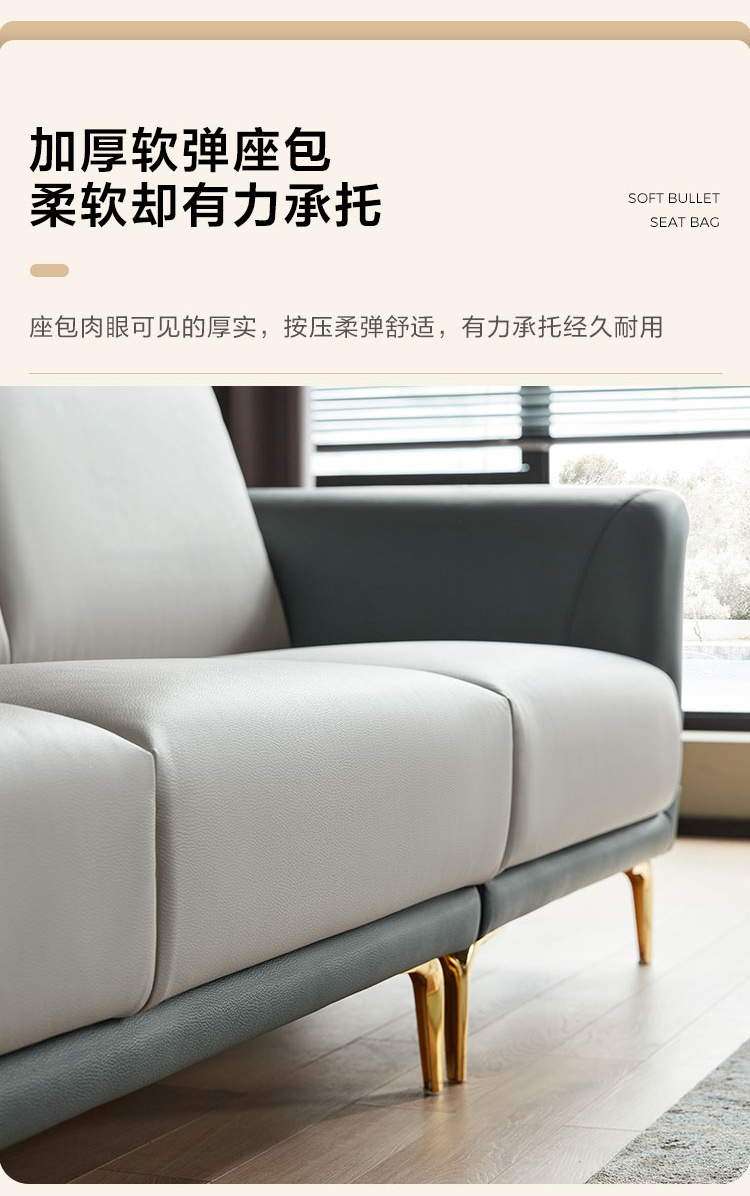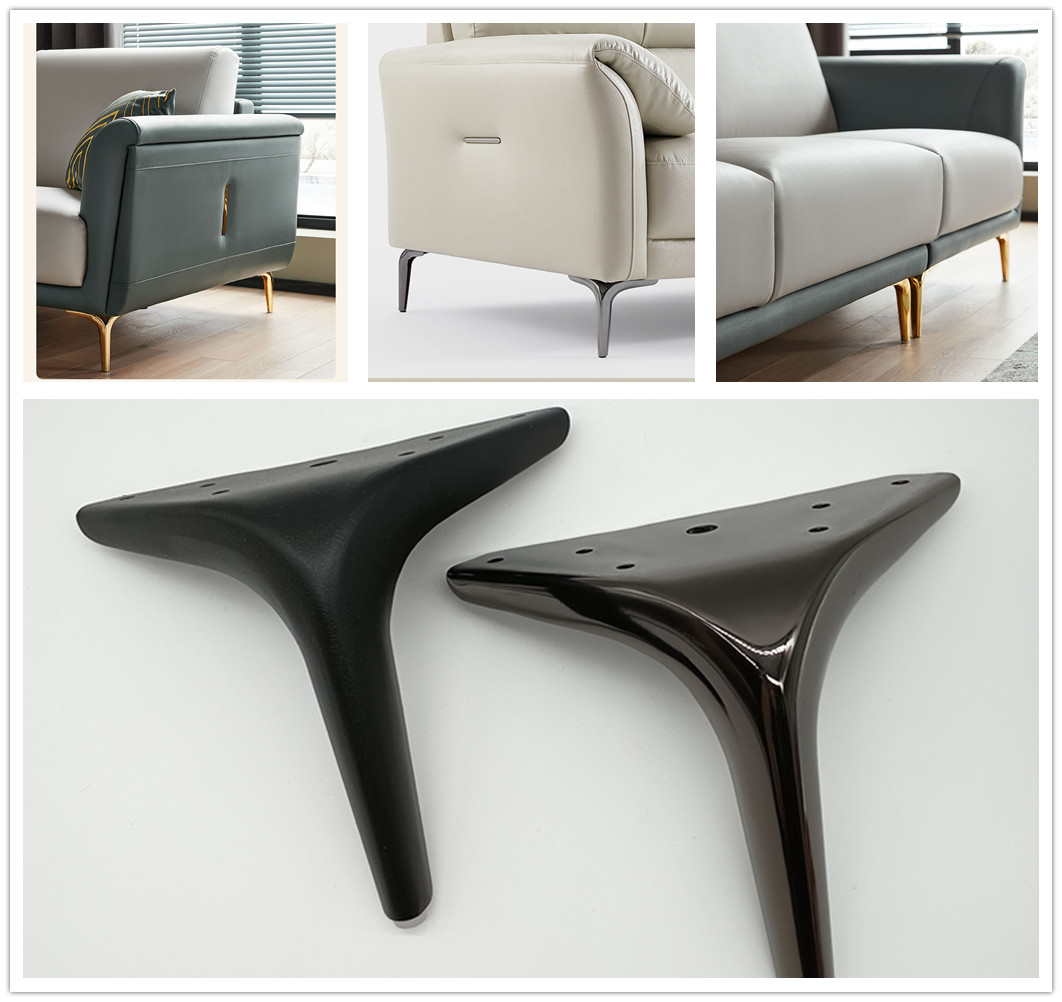Views: 0 Author: Site Editor Publish Time: 2025-10-25 Origin: Site









Sofas are a central piece of any home, blending comfort with style. Yet, when selecting a new sofa, one detail often gets overlooked—the legs. Metal legs have become a popular choice in modern furniture design, but are they the best option?
In this article, we’ll discuss the pros and cons of metal sofa legs. You'll learn how they compare to other materials and which factors to consider when making your choice.
One of the main reasons people choose metal legs for their sofas is strength. Metal is a material known for its exceptional durability. Unlike wood, which can crack or warp over time, metal legs can support heavier loads and withstand years of use. Metal legs for sofas provide stability and ensure that your sofa remains sturdy, even with constant sitting or movement.
When comparing metal to wood, metal legs are often the superior choice for strength and stability. Wood, while beautiful, may succumb to environmental factors like humidity, leading to warping or cracking. On the other hand, metal legs are much less prone to these issues and can handle more weight without compromising the integrity of the sofa.
Metal legs contribute to a sleek and contemporary look, making them a popular choice for those with modern or industrial design preferences. Available in a variety of finishes like chrome, matte black, or brushed nickel, metal legs for sofas can complement any decor. Whether you're aiming for a minimalist style or a more industrial vibe, metal legs provide the perfect finishing touch for a modern living room.
While metal legs may cost more initially than wood or plastic options, they tend to be more cost-effective in the long run. Their durability means they won’t need to be replaced as often, and their low maintenance requirements make them easy to care for. Over time, metal legs help extend the life of the sofa, making them a solid investment for those looking for value.
| Feature | Metal Legs | Wood Legs |
|---|---|---|
| Durability | Highly durable, resistant to rust and corrosion | Less durable, prone to scratches and warping |
| Stability | Provides excellent stability and support | Stable but may be less sturdy over time |
| Maintenance | Easy to clean and maintain | Requires regular care like waxing or polishing |
| Aesthetic Appeal | Sleek, modern, and contemporary look | Warm, traditional, and rustic feel |
| Suitability | Best for modern or industrial styles | Ideal for traditional or cozy spaces |
| Cost | Typically more expensive | More affordable in most cases |
| Floor Protection | May cause scratches on delicate floors | Less likely to damage floors if moved carefully |
One of the most significant benefits of metal sofa legs is their ability to provide stability and support. Metal legs reduce wobble and movement, ensuring that your sofa remains secure, even with heavy use. This stability is particularly important for larger sofas or in households with pets and children.
Metal legs for sofas are relatively easy to clean and maintain. Unlike wood, which may require waxing or polishing, metal legs can be wiped down with a simple cloth to remove dust or dirt. They are also resistant to moisture, so there's less risk of damage from spills or humidity.
Metal legs offer superior durability, making them less susceptible to wear and tear compared to wood or plastic. Steel, aluminum, and stainless steel legs are resistant to rust and corrosion, even in humid environments. This makes them ideal for both indoor and outdoor furniture. Their robust nature ensures that metal legs can stand the test of time, maintaining their strength and appearance.
While metal legs bring a modern, sleek look, they may not be suitable for all interior styles. Metal can give off a cold, industrial feel, which may not blend well with more traditional or cozy home decor. For those seeking a warmer, more inviting atmosphere, wood or fabric-covered legs might be more appropriate.
Metal legs, especially those with casters, can cause noise when moving the sofa. The sound can be disruptive and unpleasant, particularly in quiet spaces. Furthermore, metal legs may scratch or dent delicate flooring, such as hardwood or tile. It's essential to take precautions, such as using floor protectors or ensuring the sofa is placed carefully on softer surfaces.
While metal sofa legs are durable and cost-effective in the long term, they do come with a higher upfront price tag compared to wood or plastic. The manufacturing process for metal is more intricate, which can contribute to the higher cost. However, this price difference is often worth it for the long-term value and durability they provide.

Both metal and wood legs have their unique advantages. Wood is timeless and offers a natural warmth that can complement a variety of home styles, especially in more traditional or rustic settings. However, wood is more susceptible to damage from humidity, scratches, and dents. In contrast, metal legs are stronger, more stable, and less prone to environmental damage, making them a better option for long-term durability and modern aesthetics.
Plastic legs are a budget-friendly option that’s lightweight and easy to move. However, they lack the stability and durability of metal. Plastic legs are also more prone to damage over time, especially if the sofa is used frequently. Metal legs for sofas provide better long-term support and resistance to wear and tear, making them the superior choice for those who prioritize strength and durability.
When selecting metal legs for your sofa, consider factors such as your budget, the durability you require, the style of your living room, and the maintenance you’re willing to commit to. Metal legs are a great choice for modern, minimalist, and industrial styles, but they may not suit every home. If you're concerned about floor protection or noise, make sure to choose a metal leg design with features to mitigate these issues.
Metal legs offer remarkable versatility in design. They can be crafted into a variety of shapes and finishes, allowing you to match your sofa to any interior style. From sleek, straight lines to geometric shapes, metal legs complement everything from minimalist sofas to more complex, designer pieces. Whether you're designing a contemporary apartment or a modern industrial home, metal legs for sofas can adapt to your vision.
Metal legs are the perfect choice for industrial or modern designs. Sofas with metal legs work exceptionally well in open spaces with exposed brick, concrete floors, and steel accents. These legs not only enhance the aesthetic of the furniture but also elevate the overall design of the room.
Maintaining metal sofa legs is relatively easy. Regular cleaning with a microfiber cloth is often enough to keep them looking pristine. For stubborn dirt, a mild detergent mixed with warm water can be used, followed by a dry cloth to remove any excess moisture.
Metal sofa legs are susceptible to rust if exposed to moisture for prolonged periods. To prevent rusting, it’s important to wipe them dry after cleaning and ensure they are not exposed to excessive humidity. For outdoor sofas, consider using rust-resistant metals like stainless steel or applying a protective coating to the legs.
While metal legs are durable, they can still get scratched. Small scratches can often be polished out using metal polish, while deeper dents may require professional repair or replacement of the leg. Regular maintenance will help preserve their appearance and longevity.
In conclusion, sofas with metal legs provide durability, stability, and modern appeal. They are ideal for those who want strength and low-maintenance furniture. However, they might not suit all interior styles, especially traditional ones. For long-lasting quality and a contemporary look, metal legs are an excellent choice. Consider potential drawbacks like floor damage or noise before deciding.
Final Verdict: Metal sofa legs are perfect for durability, style, and ease of maintenance. For a reliable option, consider exploring products from KUKI, offering premium metal sofa legs that provide both elegance and durability.
A: Metal legs offer durability, stability, and a modern aesthetic. They are low-maintenance and perfect for contemporary designs.
A: Metal legs are more durable and stable, while wood legs offer a warmer, more traditional look. Metal is better for heavy-duty use and modern styles.
A: Yes, metal legs are easy to clean and maintain. They are resistant to moisture and require minimal care, unlike wood legs which need more attention.
A: Metal legs provide excellent strength, longevity, and a sleek, modern appearance, making them ideal for contemporary or industrial decor.
A: While metal legs are durable, they may cause scratches on delicate flooring if not protected. Using furniture pads can help prevent this.
A: Generally, metal legs tend to be pricier due to the materials and manufacturing process. However, they offer better durability, making them a good investment.





